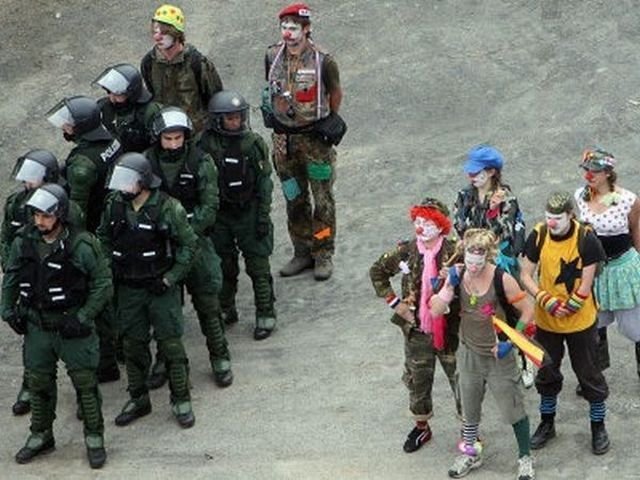
Contributed by John Jordan
When: 2003—Present
Where: London, then global
To some, the Clandestine Insurgent Rebel Clown Army (CIRCA) might appear to be but a ragged bunch of activists sporting false noses, a smudge of grease paint, camouflage pants and bad wigs. And those people may be right. But it is also a highly disciplined army of professional clowns, a militia of authentic fools, a battalion of true buffoons.
Art activist John Jordan and colleagues L.M. Bogad, Jen Verson and Matt Trevelyan founded CIRCA in late 2003 to welcome arch-clown George W. Bush on his royal visit to London. CIRCA aimed to be a new methodology of civil disobedience, merging the ancient art of clowning with contemporary tactics of nonviolent direct action. It went on to be a successful meme and international protest phenomenon, with self-organized groups taking action in the streets outside summits and military bases in dozens of countries from Colombia to New Zealand.
CIRCA worked with professional clowns to develop a methodology, rebel clowning, that introduced play and games into the process of political organizing. We developed a series of trainings that encouraged activists to reprogram their bodies, to develop their intuition and to “find their clown” — a childlike state of generosity and spontaneity. Rebel clown trainings attempted to peel off the activist armor and find the vulnerable human within.
Emphasizing the inner work of personal transformation that too many movements ignore, CIRCA viewed both soul and street as sites of struggle. The deep work of clowning, involving real letting go and finding the absolute spontaneous self, can have profoundly liberating psychological effects on participants. CIRCA’s combatants are not meant to pretend to be clowns, they should be real clowns. Clowning is a state of being rather than a technique.

It’s a core CIRCA premise that mocking and utterly confusing the enemy can be more powerful than direct confrontation. In one instance, a seventy-person-strong gaggle of clowns walked straight through a line of UK riot cops who, strangely, could not hold their line. When the video footage of the event was examined, it turned out that beneath their visors the cops were laughing too much to be able to concentrate. Other clowns filled their pockets with so much strange junk that it took hours and lots of paper work when stop-and-searches occurred. A favorite tactic was to walk into army recruitment agencies and, in a clownish way, try to join up, thus causing so much chaos that the agencies had to close down for the day, whereupon CIRCA would set up its own shabby recruitment stall outside.
Turn-of-the-century anarchist Emma Goldman posed this problem: “how to be one’s self and yet in oneness with others, to feel deeply with all human beings and still retain one’s own characteristic qualities.” CIRCA bridged that divide, allowing participants to discover their own inner clown while at the same time wearing a “uniform” that made them feel part of a strongly bonded group.
Why it worked
Rebel clowning was a gateway for lots of people to get involved in radical politics who were otherwise put off by its seriousness. For many recruits, it was their first experience of civil disobedience, but the playfulness and mask-like make-up empowered them to be deeply disobedient, often in unexpectedly absurd and creative ways.
Key Tactic at work
Carnival protest
The use of carnivalesque forms of resistance was a key tactic for the global anti-capitalist mass actions of the 1990s. CIRCA took this carnival spirit deeper into the individual mind and body of the activist. Clowning exists on the borderlines, dancing delicately on the edge of chaos, somewhere between life and art, being and pretending. Clowns are both fearsome and innocent, wise and stupid, healers and laughing stocks, scapegoats and subversives. They take this carnivalesque spirit with them wherever they go, infecting the body politic with insurrectionary dreams. When a crisis hits a culture, perhaps it is in these gray zones of creative uncertainty that we might find the answers.
Key Principle at work
Use absurdity to undermine the aura of authority
Ridicule and absurdity are powerful tools against authority. To be effective, authority has to be perceived as such, otherwise people would never obey its commands. On the other hand, who ever takes a clown seriously? Rebel clowning used this slippery dichotomy to great effect, turning the tables on authority in the street by posing in mock-serious fashion next to lines of cops, as well as at the highest levels of power, by pointing out the clownish behavior of George W. Bush and other authority figures.
Get arrested in an intelligent way
Watching police handcuff and bundle clowns into police vans is always entertaining for passersby, begging the question: What did the clowns do wrong? What is this all about? An arrested clown also makes for very mediagenic images. By staying in character during the whole process of an arrest, including giving their clown army names (e.g., Private Joke) and addressees (e.g., the big top in the sky) as their real identity, rebel clowns caused much mirth and havoc in the police stations.
Rebel clowning helped reframe the media images of protests during the big summit mobilizations of the mid 1990s. A colorful band of disobedient clowns could easily capture the limelight and shift the narrative away from “violent clashes” and smashed windows.